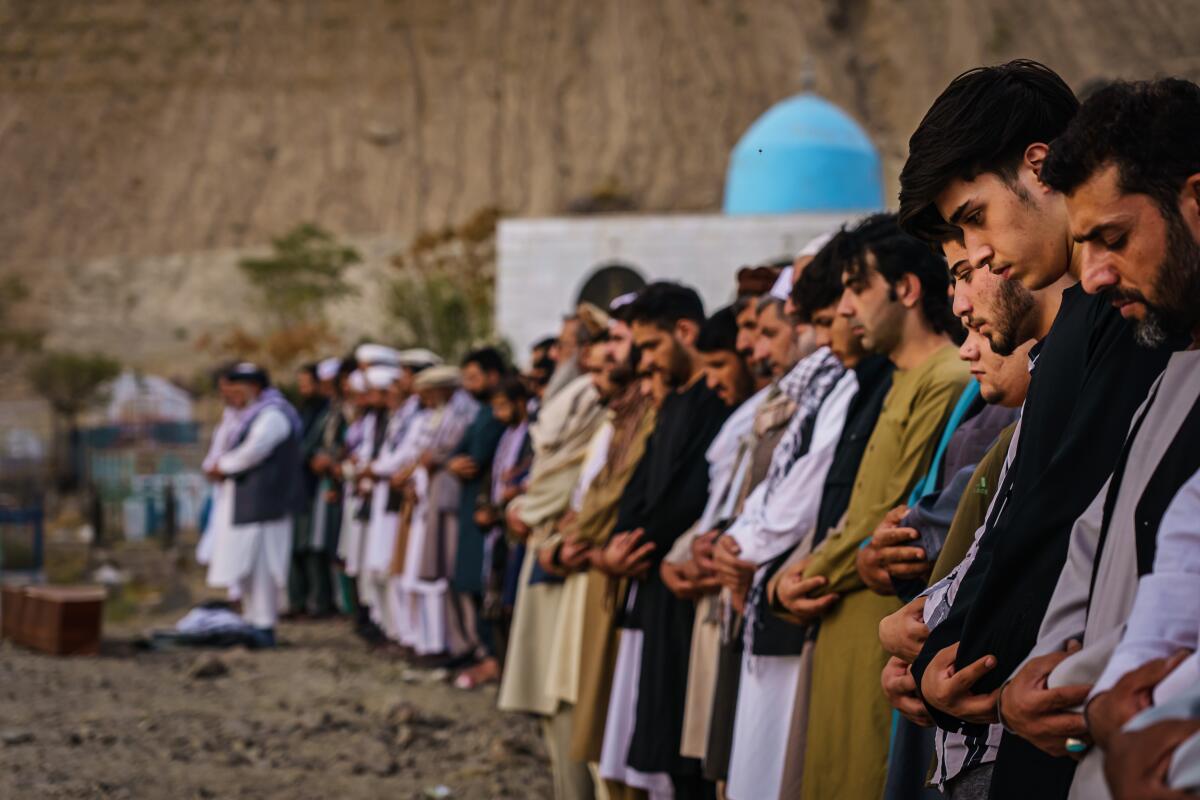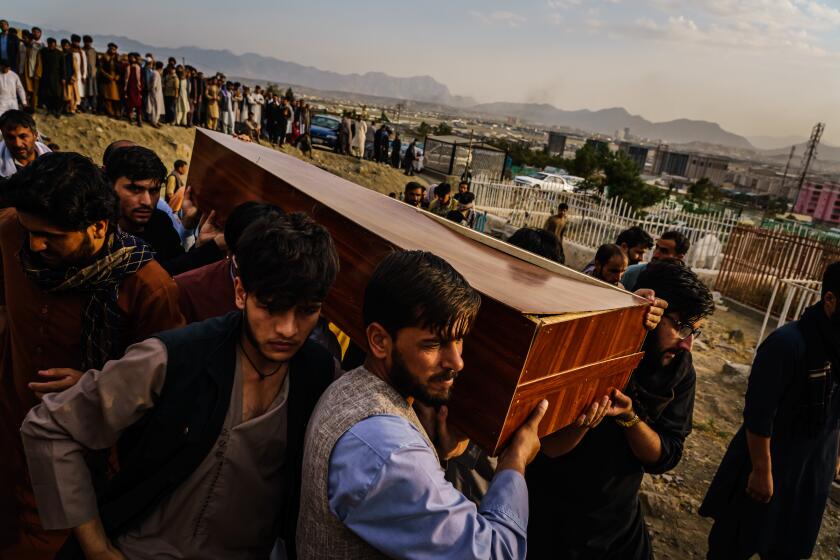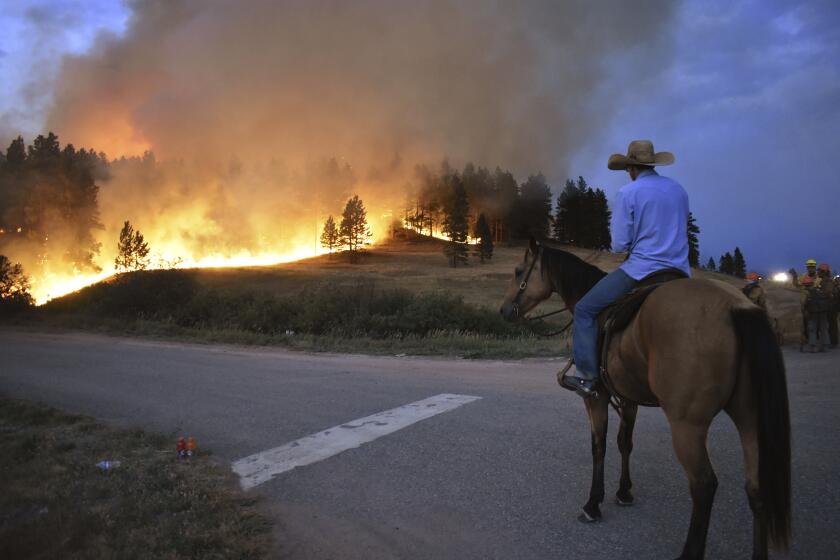Op-Ed: U.S. airstrikes are recklessly legitimizing a new kind of war

- Share via
For years, critics have sounded the alarm on targeted airstrike campaigns carried out by the U.S. Now, investigations published in December by the New York Times reveal how a secret U.S. air campaign against ISIS was riddled with imprecise targeting and flawed intelligence — further proof of a larger pattern of reckless strikes by the U.S. that have killed thousands of innocent civilians.
The mounting evidence contradicts the “promise of precision” championed by several presidential administrations that claimed airstrikes were an effective way to wage war against terrorism because they hit their targets while minimizing civilian casualties. The latest reports raise more questions as the Biden administration, while promising to impose targeting rules and civilian safeguards, has signaled a commitment to continue strikes by drones or piloted planes.
The State Department is trying to relocate some of the family members to the United States. Ten people, including seven children, were killed in a Aug. 29 drone strike the U.S. called a ‘tragic mistake.’
Over the past two decades, American presidents have increasingly relied on targeted strikes as a central feature of their counter-terrorism strategy. President George W. Bush was the first to use armed drones in the aftermath of Sept. 11. President Obama expanded the use of drone strikes and maintained a “kill list” of potential targets that he personally vetted.
President Trump, who believed that bureaucracy reduced the speed and effectiveness of airstrikes, loosened restrictions on organizations conducting strikes and their reporting requirements. Biden’s policies, so far, appear to return to the Obama-era playbook of 2016 that established an interagency checklist to conduct a strike. Yet the August 2021 drone strike in Kabul that killed 10 civilians revealed a still deeply flawed process.
Time and again, the U.S. has stretched operational definitions to the point where any strike could loosely be categorized as “self-defense” — even those that took place tens if not hundreds of miles from the actual combat zone, or far removed in time from a possible attack.
For example, Atty. Gen. Eric Holder of the Obama administration offered a definition of “imminent threat” that stretched common understandings of imminence:
“The evaluation of whether an individual presents an ‘imminent threat’ incorporates considerations of the relevant window of opportunity to act, the possible harm that missing the window would cause civilians, and the likelihood of heading off future disastrous attacks on the United States.”
Holder’s standard suggests that if American forces have a fleeting chance to take a shot, the notion of imminence applies, even if a suspected attack might be months or years away.
Self-defense became the catch-all that allowed targeting teams to justify their attacks. These strikes became the norm, and internal investigations have not stopped them.
It may be true that airstrikes have weakened ISIS, but at a terrible cost to civilians. And ISIS and terrorism remain challenges, calling into question the strategic value of airstrikes.
In addition to the civilian toll, it is difficult to ignore the precedents set. Given that the U.S. has already fallen short of its own standards of transparency and care in targeted strikes, it cannot expect other states — especially less democratic ones — to be more transparent and careful in conducting similar missions.
Thousands of Afghans have been killed in airstrikes, almost half of them children. U.S. forces may be out of the country, but civilians are still being terrorized by war.
Indeed, the U.S has arguably fed a cycle that airstrikes were meant to stop. By pioneering and normalizing drone use and targeted killings, the U.S. has in effect greenlit a new international system of unrestrained warfare.
This approach to war is a model that other countries are now following, and not just in the narrow area of counter-terrorism. Amid conflict between Armenia and Azerbaijan over the Nagorno-Karabakh territory in the fall of 2020, Azerbaijan’s drones transformed the battlefield as infantry, tanks and air defense systems were vulnerable to drone attacks. The Ethiopian government has used drones in its ongoing civil conflict, and a growing number of states are exporting drones to other countries. Militant groups are deploying drones, including reportedly to attack U.S. troops, while Mexican cartels are using drones in turf wars.
As an unintended consequence of shortsighted American actions, the U.S. military now is at risk from the very types of technology and tactics that it developed. Meanwhile, American citizens face the bitter irony that the next 9/11 could involve the use of drones, and the whole world faces the great threat of global drone wars.
Reckless strikes undermine the United States’ claims to be different from its enemies due to the care it takes to prevent civilian casualties. It is a tall order to ask service personnel to balance competing considerations of U.S. national security, the conditions of being at war and the international humanitarian laws meant to govern armed conflict in every single decision. But moral nations must do so.
It’s time that Congress reclaimed the blank check it gave the executive branch to conduct strikes and, however difficult, repeal or modify the 2001 and 2002 Authorizations for Use of Military Force that launched too broad a mandate for counter-terrorism efforts. For its part, the executive branch needs to stop claiming self-defense as the fallback justification for any questionable strike. For too long, the military has legitimized the expanded use of these attacks — made possible by a culture of unaccountability and impunity.
Government and national security insiders were apparently comfortable accepting drone-strike civilian deaths as “the misfortunes of war.” Now, American servicemembers and civilians face being in drone crosshairs themselves. The U.S. created and expanded this problem. It must account for American principles and the global audience looking to the U.S. for the standard it sets. We have to remember that the foremost principle of self-defense is that you must not destroy that which you are trying to defend.
Christopher Faulkner is a postdoctoral fellow in the national security affairs department at the U.S. Naval War College, where Andrew Stigler is an associate professor in national security affairs. Jeffrey Rogg is an assistant professor in intelligence and security studies at the Citadel. The views expressed are the authors’ own and do not represent their respective institutions.
More to Read
A cure for the common opinion
Get thought-provoking perspectives with our weekly newsletter.
You may occasionally receive promotional content from the Los Angeles Times.












